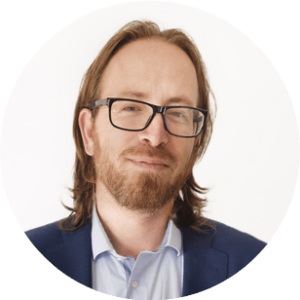Email subject lines are a critical inflection point for an email’s success. If your subject line captures subscribers’ attention, you get a chance to impress them with your email’s content. If not? Well, it’s not a pleasant fate. How can you employ subject lines to your best advantage for earning the open and setting the stage for conversions? Find out in this ultimate guide to crafting strategic email subject lines.
I want to open this post with rotten tomatoes (the fruit, not the website). Today, nobody throws tomatoes anymore. Or any rotten fruit for that matter.
You can learn about your performance dashboards. I’ll give you that.
But you know what you can learn from rotten-tomatoes flying toward you at high-speed?
To respect your audience –fast.
Rotten tomatoes offer instant learning opportunities.
When one heads toward your head, you either duck and learn your lesson. Or you don’t and you’re done.
Avoiding rotten tomatoes projectiles was the life in the public speaking arena that was the ancient Roman forums. Those audiences didn’t mess around.
Speakers either grabbed attention quickly or they were out and their message lost.
Your customer’s inbox is pretty much a modern representation of a Roman public forum. Everyone is fighting to get attention. And much like the forums mentioned above, reactions to your email subject lines will be pretty Dichotomous, Maximus.
Either 👍 or 👎.
Lucky for you, a mistake in the inbox won’t take you out of the game. Still, there’s a lot riding on the split-second decisions made by subscribers who may be busy, distracted, or just in the middle of sipping on a can of `nope’ juice.
Whether your message will spark a conversation (and conversion) or get your message thrown in the trash like rotten fruit depends on the impression your inbox display makes.
Before you schedule your next send, ask yourself:
- Is your pre-opening content designed to get you noticed?
- Do your subject lines give subscribers a reason to want to keep reading?
- Are your list members online or even awake when you’re sending your message?
- Is your content relevant for them at that moment? Or at all?
There is a way to stand out in the inbox without resorting to clickbait or other tactics that can cost your subscribers’ trust and engagement and harm your deliverability rates.
Walk with me through this guide to creating subject lines that attract attention and entice opens. Learn step-by-step how to craft email subject lines so good your competitors will want to build a colossus for you.
What makes an email subject line successful?
Your subject line doesn’t enter the inbox alone. Backing every successful subject line are many variables such as send times and sender reputation. Inbox placement and subscriber activity affect whether your subject line is ever seen. In the inbox display, your subject line doesn’t stand alone either. An email’s subject line is one of several elements that combine in the inbox display to convey the relevance and importance of your message to subscribers.
Because there are so many variables, assessing the success of your subject lines isn’t easy.
Plus, the metrics we use to evaluate a subject line’s effectiveness aren’t as accurate as they once were. Apple’s release of iOS 15 and its enhanced Mail Privacy Protection (MPP) feature along with other email clients caching and review policies have rendered open rates less precise and useful for email marketers.
Because nearly 40% of all email opens occur on iPhones, MPP has had the most significant impact on open rates as a metric, though.
Apple’s MPP privacy feature is preventing email marketers from:
- Tracking recipients’ geolocations.
- Inserting real-time images into email content.
- Receiving email open data.
Privacy protections are popular with email users and Most iPhone users opt-in for Mail Privacy protection. I’m not an oracle, but this probably means that Google will be offering similar features soon.
But, then again, is that really so bad?
Getting an email opened is a critical milestone on your path to victory, but it isn’t an end unto itself. After all, an open is just an open. What matters is the follow-through.
Measuring email subject line success with clicks and conversions
The knowledge gained through monitoring open rates was always limited. Discovering how many subscribers clicked on your subject line to view your email’s message doesn’t tell you whether they were interested in what they found inside. It’s that interest, your subscribers’ engagement with your messages that tells the full story.
“Just because you have a good subject line does not mean the message is going to work.” ~Ryan Phelan, Co-Founder of Origin Email Agency
Your click-through rate (CTR) and conversion rate (CR) are better measures of subscriber engagement and whether your subject line is furthering your campaign’s objective.
Use Ongage’s conversion point system to track your email’s performance and just your subject lines by what they ultimately achieve. This system enables you to define a conversion event, then track your email from the first click-through until the event occurs.Conversion data allows you to identify whether your subject lines resonate with the right prospects–those ready, willing, and able to convert.
Other ways email subject lines benefit your email campaigns
Without a good subject line, we know that you aren’t getting in front of your audience and won’t have a chance to convince them to click on your CTA. But, a great subject line can do even more for your brand. A well-crafted subject line lays the foundation for future exchanges and can start a relationship that pays off for years to come.
Great subject lines get opened, and that impresses ISPs. Even though you may not be able to view your open rates, ISPs can. Email clients use this data as an indicator of your email’s value to subscribers, to calculate your sender reputation and decide your email’s deliverability.
Engagement is a key driver of inbox placement with leading ISPs. This is why having subscribers who receive your emails but never open them is worse than losing list members through unsubscribes. Sending emails to unengaged subscribers will drag down your deliverability rates.
Consistently low engagement rates tell ISPs that you aren’t tailoring your message to your audience or don’t know your audience at all.
Also, the subject lines of unopened emails still present an opportunity to communicate with your subscribers. Your message’s inbox display can convey your brand’s personality, begin or continue a conversation and deliver value.
For example, the subject lines in this welcome series from Thrive Market tells the brand’s value story.

In order, the subject lines and their accompanying preview texts say:
- How does Thrive Market help you save? – Glad you asked! Guaranteed savings, free gifts & so much more.
- Ends soon: EXTRA 35% off your first offer! – Plus, a FREE exclusive gift (up to $24 value) when you finish signing up for your membership.
- What makes us different from the rest? – We’re redefining grocery shopping. WIth meticulous standards & thousands of healthy…
This copy set tells new subscribers that the brand offers deals and free gifts and encourages them to act.
These order status subject lines from Sam’s may not earn opens but definitely enhance customers’ experiences by allowing subscribers to get quick updates without clicking.

Beginning with an order confirmation, the inbox set says:
- Thanks for your Sam’s Club order … – We’ll connect when your order’s ready.
- Your SamsClub.com order has shipped – Your order is on its way
- Order #… is out for delivery – Thought you’d be excited.
- Your SamsClub.com order was delivered. – Thanks for shopping with us
Remember when I mentioned “respect your audience” at the beginning of this post? These two do just that in their own way.
Supporting your brand’s mission, delivering value to your subscribers, and building long-lasting relationships require looking beyond single campaigns toward an even grander vision of success.
Next, I’ll tell you how to build this vision into your subject line strategy.
Tailor your subject lines for your brand, objective and audience
As the cliché goes: Rome wasn’t built in a day, and neither are great email campaigns.
Over half of email marketing professionals responding to a recent survey reported spending at least two weeks developing each email campaign. And it’s not uncommon for large email teams to be working on up to 25 different campaigns in different stages of production simultaneously.
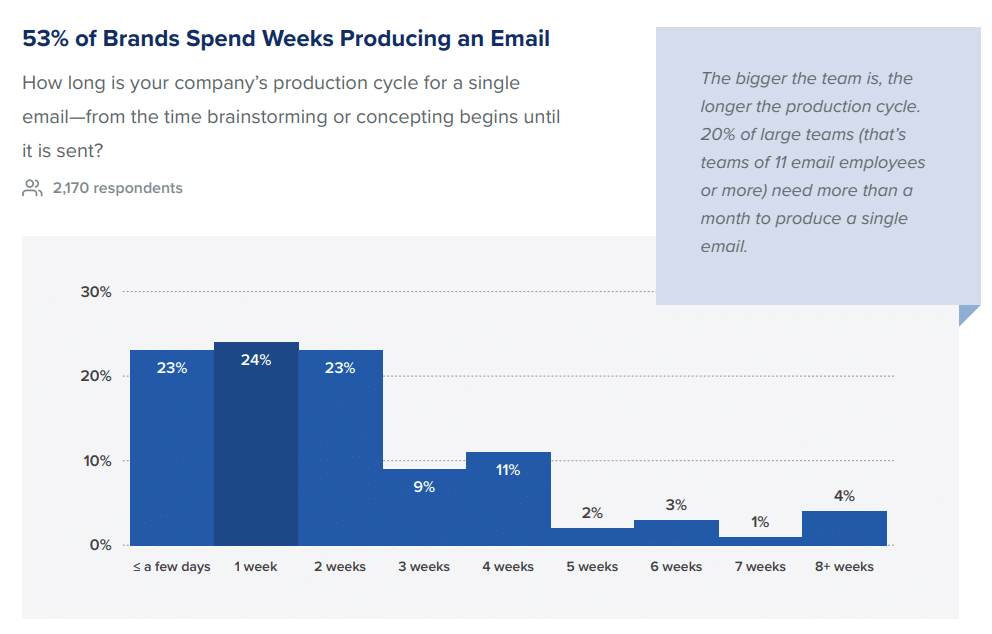
That’s a significant investment of time and mental energy. You guys know who you are. Kudos to you!
Maximize the return on your campaigns by using subject lines that are:
- Aligned with your brand’s marketing message.
- Support a conversion-focused mindset.
- Specific to your audience.
Here’s how to combine these three elements.
Maintain your brand voice and messaging in your subject lines
Coordinate your email subject lines with your other marketing campaigns’ messaging for cohesive, consistent communications that reinforces your brand message and capitalizes on your brand’s name recognition. The more consumers see and hear about your brand, the more familiar it becomes.
This familiarity will help your subject lines stand out in the inbox.
Additionally, subject lines that are true to your brand personality communicate authenticity and earn your subscribers’ trust. Plus, by consolidating data and feedback from your organization, you’ll save time and gain better insights into your audience.
Choose your conversion goal before you choose your inbox copy
“All roads lead to Rome.” -echo, echo, echo-
During the height of the Roman Empire, a series of roadways radiated out from Roma, connecting the capital city with most of the known world.

Wherever travelers began their journey, they could follow these carefully designed and maintained roads to Roma–the center of Roman life.
Where do the elements of your email lead?
If your sole goal for an email campaign is to register opens, then a directionless subject line may suffice. But most of us have conversion in mind when we plot a course for our subscribers’ inboxes.
Make sure your journey ends as you intended – by defining your campaign’s conversion event and developing a conversion-focused CTA before diving into your subject line. Discover how to strategize and implement a CTA-first, conversion-focused campaign in our previous post about email call-to-action.
Know your audience so you can create subject lines that speak their language
You can take plenty of different approaches to gain attention in the inbox. You can add emojis or numbers, ask a question, spark curiosity or use one of many other persuasive devices.
However, what attracts one person may not appeal to another.
Persuasiveness begins with knowing who you want to persuade.
Are your subscribers the type who will be driven by curiosity to click on a mysterious subject line? Or, do they not have time for fun and games and just want you to tell them what’s in it for them?
According to the language optimization platform, Phrasee, 2020’s seasonal shoppers favored email subject lines that got to the point over those that aimed to be offbeat and happy emojis over silly ones.
Who is your campaign intended to reach?
Sharper Image and Well+Good are promoting similar products in the subject lines below. But the persuasive devices they employ target two very different audiences.

Sharper Image uses digit and symbol characters and urgency to grab attention in its inbox display that says,
Our #1 Backrest Massager is selling out fast! Get yours now while it’s still in stock.
Well+Good uses digit and symbol characters, too. But the message is aimed at assistance over urgency. It’s subject line and preview text says,
This $8 scalp massager can help with hair growth – Plus: How to keep coffee fresh longer
To achieve above average results for your email campaigns, use what you know about who will read your message to understand their expectations, wants, needs and preferences. As you learn more about your subscribers, develop customer personas to help your team visualize the people who will read their email messages.
Combine information from multiple data sources in your CRM to segment your audience. Then develop hyper-targeted subject lines to attract, engage and win them over.
With these foundational elements in place, you’ll be ready to excel in the inbox using the practices and copywriting tips I’ll share in the following sections.
Email subject line best practices to seize subscribers attention and drive conversions (with examples)

When it comes to writing email subject lines, you’ll find plenty of advice about what to say and how. The following list of best practices includes data-backed advice and tips from email experts.
However, just because something worked for another brand or was influential in the past doesn’t mean it’s the best strategy for your subject lines. There are just too many unknown variables for a single set of recommendations to apply in every situation.
What the average subscriber likes or prefers may not appeal to your audience at all. Also, what worked last year or even last month may fail today.
Don’t get complacent and don’t be afraid to break the rules.
Someone has to be the first to try the next big thing. It might as well be you.
Use these tips as a starting point for developing conversion-focused subject lines and inbox presentations that resonate with your audience:
Start with a comprehensive subject line strategy
Your first step toward subject line supremacy is to put your foundational knowledge to use.
Here’s how:
Leverage your brand voice and messaging to stand out in the inbox like a familiar face in a crowd. Don’t go too far off script when crafting your subject lines. Surprises can be fun. But people tend to prefer consistency when it comes to the brands they trust.
Casual wear brand Chubbies stays true to form by maintaining its irreverent tone of voice throughout this 14-day sequence.

Focus your subject line and preview text on your primary objective and your chosen CTA. Your pre-opening content is your first opportunity to plant the seeds of conversion in your subscribers’ minds. Use this space to focus their attention on what matters most to you (and your goal).
Take a look at how Nir Eyal sets up his ask in this survey email with an “ask a favor” subject line that perfectly matches his email’s CTA.
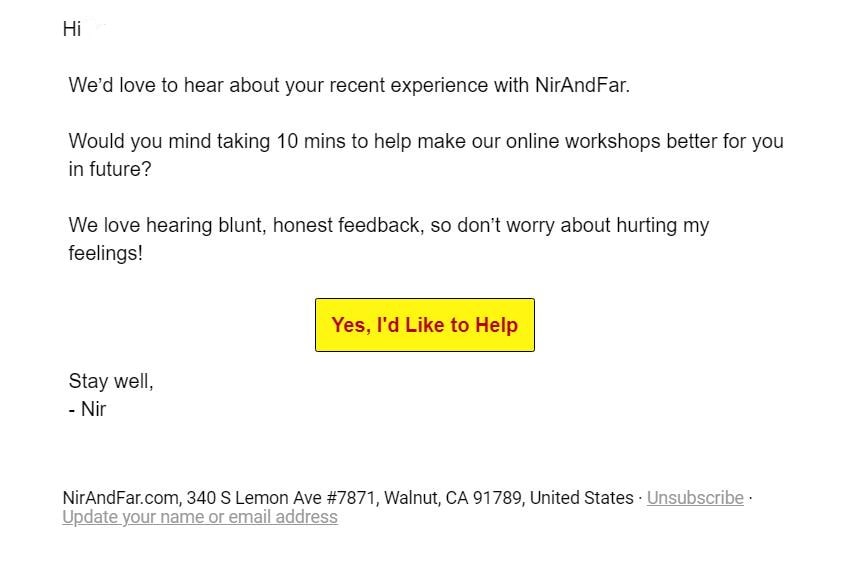
There’s no chance of subscribers wandering off track when engaging with this email campaign.
What if your email has more than one CTA or conversion objective?
Most experts recommend sticking to one goal in the subject line and preview section because you don’t have a lot of characters to work with. Try creating smaller segments and choosing a targeted CTA for each one.
Or, go your own way by including multiple topics in your subject line.
The newsletter subject lines in the image below show how it’s done.

Korn Ferry Institute’s subject line announces the message’s content, “Will Hiring Slow l Requiring Booster Shots l Zoom Foul–ups.” KeenGamer also tells what’s inside with a subject line that says, “What You Need to Know About the Alan Wake Remaster, Predictions for the PlayStation Showcase, and More!” Meanwhile, EdWeek l Spotlights sent an email with the subject line, “Save Reopening l Mental Health l Literacy l Online Safety.”
Match your subject line’s tone to your email’s purpose. Even the coolest, hippest brands sometimes have to share serious information with their subscribers. Be mindful of the mood your email’s subject line sets.
For instance, when sending messages about data breaches or overdue payments, skip the wit and keep your subject line straightforward.
Investment platform Robinhood distinguishes its newsletter and transactional content with different tones in the subject line and a different From name.

The brokerage firm’s transaction message subject line and preview text from the sender name, Robinhood, says, “Your order has been confirmed – You have submitted a market order to sell 20 shares of GSAT. Your order has been confirmed…” (Notice how subscribers can see key information without having to open this message?)
Robinhood’s newsletter is distinguished by the From name, “Robinhood Snacks.” This subject line has a more casual tone and an emoji: 🥤 The job situation, feat. expiring unemployment $$.
Make sure your subject lines go with the flow. Many of the emails you prepare aren’t part of a single campaign. Instead, they are part of an automated series. These emails are event-triggered and sent at specific intervals. So whether your subscriber opens each one or not, their presence in the inbox gives you a chance to engage.
Prepare your series of email subject lines and preview texts in batches. View them as your subscribers most likely will–in the order of receipt. Use light repetition to reinforce your message across these emails. But also mix things up. Don’t bore your subscribers.
This 3-email webinar invite series from JobScan makes two different free offers before escalating the urgency with a “Last call!” subject line.

Here’s how the Jobscan Team’s email inbox set escalates its urgency:
- FREE job search webinar series! – 12 expert career coaches. 8 topics. 10 days. Totally free. It’s time to master your job search.
- 5 free scans + Jobscan’s No Fear Job Search Webinar Series – Share this page with your network and we’ll give you 5 free scans…
- Last call! Sign up for the FREE job search webinar series! – 12 expert career coaches. 8 topics. 10 days. Totally free.
(Jobscan reuses portions of its inbox copy for different messages. This tactic facilitates A/B testing and allows you to use your best stuff more than once.)
Select persuasive devices and make word choices based on the specific characteristics of your target audience. It’s not just your subject line’s primary focus that you should tailor to your audience. Maximize your impact by using the right pitch for each of your subscriber personas.
For example you might try “30% off sales starts today! Free shipping on all orders” in the inboxes of your price-conscious segment. And “30% off your favorite sustainable brands! Minimize your carbon impact with our free eco-friendly shipping options” in the inbox of your environmentally conscious customers.
In the inbox excerpt below, two distinctive e-commerce grocery sellers make two distinctly different appeals.

Thrive Market’s subject line and preview text says, “The easiest, healthiest way to stock your pantry – Get everything you need for a healthy home. We make the perfect pantry easy…” In contrast, The Team at Mouth writes, “Open wide! – American-made products you’ll love… MOUTH.com.”
Magnify your subject line’s effect by optimizing other inbox elements
What your subscribers see in their inbox influences their decision to open or not, and what they want to see is names they can trust and content that offers value.
These From Name and preview text best practices will help give the people what they want.
- Use a recognizable sender address. Who your emails should be from is the subject of much debate in email marketing circles. Should you send your messages from an individual to make them appear more personal? Should you leverage your brand or product name because they are more familiar to subscribers?
Choose a sender identification that is short and clear because space is limited.
Then, test a few different strategies to find what works for your subscribers. Check out the variety of approaches featured in the example below:

Some senders use only their brand name. Others, such as Refinery 29 and Bespoke, go with a branded sub-address. Another option is to use a specific product name to identify your emails.
Using an individual’s name gives your emails a more intimate feel. However, subscribers might not recognize the email from you without a brand affiliation. Instapage combines its brand name with an individual’s name, Tyson, for a more personal approach.
Alternatively, you can add a human element by including both your brand and an individual’s name or the word “team” in your From field.
Avoid using generic phrases like “support,” “info,” or “DoNotReply” as your From name. Your subscribers want to know who they are receiving a message from before they click.
- Implement BIMI for an inbox edge. The Brand Indicators for Message Identification (BIMI) protocol opportunity for you to upgrade your inbox presence by adding a logo next to your From name.
The protocol has been around for a while but may pick up steam now that Google has announced that it will join Yahoo and Verizon Media in supporting BIMI.

- Use Gmail Annotations to boost your promotional presence. Exclusively for use in the Gmail Promotions tab, the Annotations feature allows senders to add images, offers, expirations dates, and other details to their inbox display by adding a JSON-LD script to their email’s HTML header.
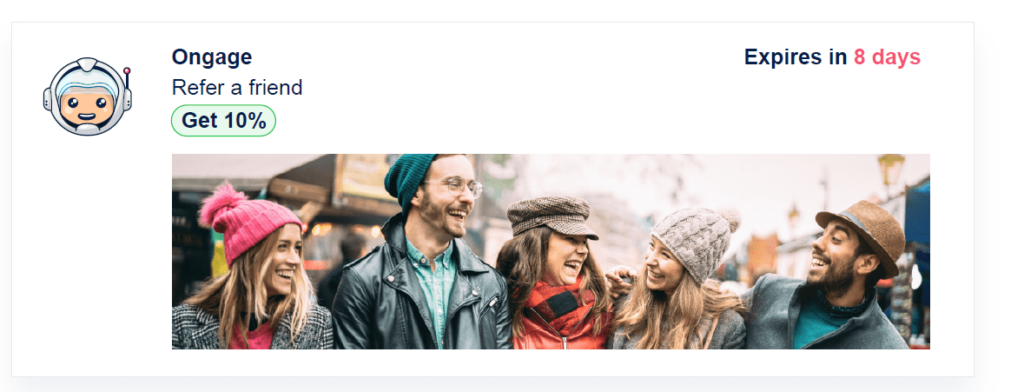
Gmail has 18% of the email client market and accounts for 27% of all email opens. That’s a lot of eyeballs!
- Use your preview text to extend your message. Inbox space is a precious commodity. The number of characters on display varies by device and mailbox provider. Make every word, symbol, and emoji count by using your preview copy to supplement your subject line.
You’ve probably seen plenty of preview sections like this one from MoMA Design Store that complement the subject line by adding more details.

“Shop Now, Save 15% Later – Now through Labor Day. MoMA Design Store Shop Now Variable Balans Ergonomic Kneeling Chair…”
⚠️The extra copy following the subject line and preview for MoMA’s email, is from the email’s body. This overflow copy can detract from the impact of your chosen text. Use the preview test spacing hack to avoid this situation.
The Ann Taylor clothing brand does more than expand on the details in its preview copy. It uses the space to suggest a solution to subscribers’ wardrobe woes.

“Ready for a Workwear Update? – This Sale Can Help Get You Office-Ready,” is the pitch to get subscribers to open the message from Ann Taylor.
Get creative with your subject line and preview text by creating a call and response, question and answer, or problem and solution combination.
Run a tight ship and keep valuable space by not repeating yourself like in the examples below:

There’s no need to repeat your From name in your subject line or announce that your message is about a webinar more than once.
And above all, don’t let your preview space go to waste by failing to customize this content. “VIEW IN BROWSER” isn’t a compelling offer.
How do you customize your preview text?
The copy that appears at the top of your email’s HTML code will show up as your preview text. Place your desired text first in the code, before your traditional preheader copy.
Is capitalization in email subject lines good or bad? Use a mix of letters, symbols, and emojis in the inbox to capture subscribers’ attention

The classic saying, “When in Rome, do as the Romans do,” celebrates adapting to and imitating whatever culture you find yourself in. But, sometimes imitation leads to a lack of innovation.
Best practices are just regular practices. Going against the tide can sometimes pay off.
Unusual approaches stand out in the inbox. If you’re the first to try a new strategy, your subscribers may notice and reward you with their attention. On the flip side, there is such a thing as going too far.
Here are some suggestions to get you started:
- Mix up your letter cases. We’ve been told not to use all caps in the subject line for years because capital letters may be perceived as digital SHOUTING. Plus, Using Title Case or All Caps Can Make a Sentence Difficult to Read.
It’s a valid argument. You want to stand out in the inbox, but you don’t want to add friction. However, a quick scan of my inbox reveals that many email marketers are testing letter case boundaries.
Some use title cases, while others stick with sentence cases. More than a few brands inject all caps words into their subject lines. A few brands are even capitalizing the entire subject line.

Which ones do you think stand out? Will your audience agree?
- Emojis in singles or groups. I’ll confess. I like emojis (and GIFs and stickers, and I have a horrible sense of humor, but that’s not the point of this post!). Their bright splash of color stands out in my inbox.
Use emojis to complement your copy and add some flair. Be creative with your emoji selections. Try something other than 🔥. Use your email’s theme, subscribers’ interests, events, or holidays to inspire you.
Check out how these senders use emojis in the inbox to help catch subscribers’ eyes.
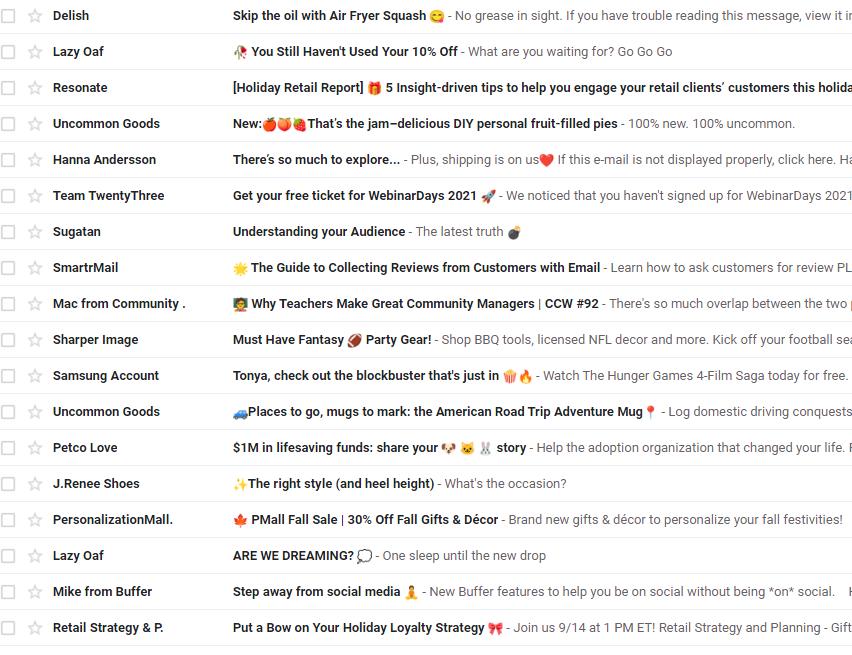
A word of advice, don’t use emojis if you’re not 100% sure that you know what they mean.
The meaning of an emoji can change in a flash. Do a quick check, just to be sure.
Also, don’t substitute emojis for words. This forces your subscribers to perform mental gymnastics to understand your line, and you’ll decrease your email’s accessibility. The subject line below would say, “We purple heart 2021 summer self-striping Felicity projects,” when read by a screen reader.

Finally, test your emoji’s appearance across devices to make sure they render correctly and use a tool such as the free version of the NVDA screen reader to hear what they sound like for yourself.
- Play with punctuation. Should you punctuate your subject line like a sentence? Are extra exclamation points okay? The answer to these questions may depend on your brand.
Each of the brands below chose a different strategy.

I noticed an uptick in subject lines using ellipses, parenthesis and words.separated.by.periods. in my inbox recently. These little extras can break up your subject line and help it stand out.

- Keep up with the times. Show your subscribers that your brand is listening by mentioning trending topics. Use tools such as Answer the Public, Google Trends, and Also Asked, as well as social media, forums, and your customer data to stay on top of what’s on your subscribers’ minds. Keeping up with current trends and sentiments will also help you avoid sending an out-of-touch message.
These subject lines below cover everything from holiday plans to workplace issues.

In the subject lines set above, Well + Good asks subscribers, “Feel like you could use a break from hustle culture?” Retail Touchpoints’ subject line announces its message topic, “Why retailers need more than wage increases to win the hiring war.”
Sending from Today on R29, Refinery 29’s subject line asks, “Why does Kim Kardashian’s fully covered Met Gala look say about America?” And, Enjoy Life foods wants subscribers to know that “Fall treats are in! 🎃”
How long should an email subject line be?
Be deliberate when choosing the word and character counts for your subject lines. Both long and short subject lines have their advantages. Short subject lines are easily scanned and don’t get cut off when viewed on mobile devices. But, newer studies suggest that lines with 110+ characters get more opens and clicks. And a long subject line can stand out in an inbox full of shorties.
The selection of emails below contains both long and short outliers.
This display is from a desktop inbox so there’s more room to spell things out. But which lines caught your eye?

Going for short and concise?
Here are some tips for making each of your subject line characters count:
- Lead with the important stuff. What your subscribers see may be less than what you write. Display cut-offs vary by mailbox provider and device. On average, desktop viewers will see around 60 characters, while some mobile devices cut to the ellipse after a mere 35 characters.
Regardless of whether you go with a long or short subject line,
– Put the most compelling content upfront –
An excellent example of that can be found In a recent test Jeanne Jennings from Email Optimization Shop conducted.
By prioritizing value and focusing on benefits in the copy, she increased RPME (revenue-per-thousand-emails sent) by +9%.
Here are the hypotheses she used in her test:
- If the savings are significant, including a dollar or amount off in the subject line can boost performance.
- Making the subject line and preview text more benefit-oriented will often boost performance.
- Including the key copy in the first 25 characters of the subject line and preview text will often boost performance, as this is all you can guarantee the reader will see.
Last but not least. Don’t forget that you can add other details in the preview space.
Bracketed words to signal different content formats such as [ebook], [webinar] or [watch], is a trendy device for identifying what type of content an email promotes. But does this information have to go at the front of the line? Maybe not.

Test placing the content’s format label or other general information at the end of the line or in your preview copy to focus your readers’ attention on the subject matter instead of the format.
- Think about mobile users’ experiences. Mobile email clients now process more than 40% of emails. What percentage of your subscribers check their emails on mobile devices? If your subject line doesn’t get your message across on mobile, you’ll miss many conversion opportunities.
The welcome emails below employ subject lines that deliver on mobile or desktop.

- Use tools to test your subject line’s clickability and appearance. You don’t have to rely on your good taste alone to decide if your copy will get flung with flowers or rotten tomatoes. Use a subject line tester to get a second option.
Take a look at how different devices display your copy, too.
Does your promotion for “beef jerky” become a “jerk…”? Are you at risk of making an “ass…” out of an “assumption”? Avoid awkward endings by using TestSubject or EmailToolTester to see how your inbox content will look on different devices.
- Let a tool do the writing for you. AI is going to replace us all! I don’t really think so, but I love emojis, so what do I know? Okay, let me rephrase that. Maybe we’re still safe from being replaced. But you can use AI platforms like Phrasee to help you come up with a few subject lines and see if they fit you.
Not everyone can spare the time and resources to invest in their copy, and sometimes even the most creative people have bad days. AI can and will surprise.
And for the creative folk? It can be used to kick-start inspiration.
Personalize and customize your subject lines
We mention personalization here at Ongage nearly as much as we do data because these elements are critical to email marketing success. If you aren’t using all the data at your disposal to personalize your emails, you should be.
Here’s why:
- 68% of customers say a tailored experience based on their taste and preferences is important.
- 52% of consumers expect personalized offers.
- 72% of consumers say they are more likely to shop with brands offering personalized experiences.
And, if you are creating data-driven customized email experiences, why not tell your subscribers about it in the subject line?
Achieve the first level of personalization via grouping your subscribers by demographic or behavioral characteristics. Then, take your personalization up a notch with dynamic fields in your subject lines to create emails that make your subscribers feel that your brand is listening and learning how to serve them better. Melissa’s article about email personalization will tell you everything you’ll need to know about data and emails.
With competition for attention at an all-time high, you can’t risk waiting until someone opens your email to show that you made it just for them.
Here are some subject line-specific strategies for making a personal connection with your subscribers:
- Say their name. Maybe there’s a little emperor’s ego in all of us because people love to see their names mentioned. You can’t stamp someone’s name on a coin for them (unless that’s what your brand does). But, you can put it in the subject line of the email you send to them.
- Add a reference to their job title or industry to highlight that your message was made especially for them.
- Zero in on their location. Create geo-targeted segments and develop location-based subject lines that reach your subscribers where they are. Alter your subject lines to match each region’s culture and seasons.
Using dynamic content, you can narrow down your geographic targeting even more. Groupon uses its subject lines to alert subscribers to the local deals inside.
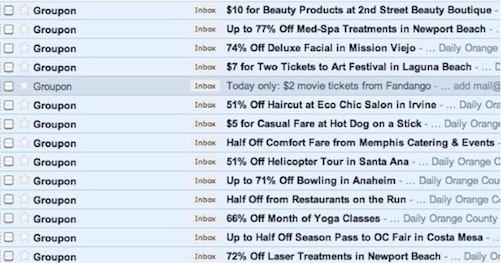
- Share their interests and affinities. If your subscribers have disclosed their interests, use your subject line to tell them when your email will be captivating.
Here’s an example from Gaia House in the UK with a subject line that shares information about new meditation retreats.

- Offer deals and suggestions you know they’ll appreciate. Wouldn’t it be great to receive emails that announced when your favorite styles were on sale or suggested new designers based on your browning history?
Your subscribers think so, according to a report by SmartHQ.
They want you to use the data you have about them to
- Offer discounts on the products they’ve wishlisted or expressed interest in.
- Send them abandoned cart reminders.
- Suggest (and offer deals) on other products they might like.
Sending customized emails to your e-commerce clients based on their browsing history can net big rewards, including:
- 65% open rates for product-focused back-in-stock email campaigns (that’s a data point before the openpocalypse, but it’s still valid.
- 39% click-through rates for personalized abandoned cart campaigns.
Earn more engagement with subject lines that tell your subscribers you’ve been paying attention to what they want. Here’s how two different brands, Steam and Zillow, do it.

- Use event-triggered automation to deliver a spot-on subject line right on time. Triggered email campaigns get 306% more clicks than non-trigger emails, and it’s no wonder. They add value for your subscribers.
I received this email from Mountain Warehouse shortly after using the search term “hiking boots” on their website.

What’s great about this is the discount arrived in time for me to take advantage of, and the subject line let me know.
If the subject line had been less specific, I might have ignored it or delayed opening it (and been pretty unhappy about missing out on this sale!)
You can create perfectly timed emails with hyper-personalized subject lines at scale using Ongage’s automation rules and dynamic fields.
- Segment your subscribers by their position in their organization. Roman society was hierarchical. Their jobs, connections, and wealth influenced their status (and vice versa). The lines of division in modern society aren’t quite as harsh, but they still exist. Particularly in large organizations, what your audience needs and wants to know differs based on their position.
You can use segmentation and separate subject lines to send the same email to professionals at different stages in their careers or job roles while appealing to everyone.
How’s that work?
Let’s say you’re offering a free webinar about a product that can help businesses increase productivity by upskilling their workforce. The webinar is suitable for both C-suite and management levels.
Highlight cost savings for your executive segment and career advancement for your management group.
Apply this same approach to creating subject lines for emails sent to both sides of a two-sided network, such as job seekers and recruiters or wholesale buyers and sellers.
How can you gather information about subscribers to tailor their experience?
- Include interest-based questions on your sign-up form or invite your subscribers to reveal their likes and dislikes via your preference center.
- Record data about their browsing and purchase histories and products they’ve wishlisted, reviewed, or recommended.
- Use third-party data enrichment services to supplement the basics, such as your subscribers’ location, gender, or other details.
Remember, being creepy, turns heads towards the door. Respect your subscribers’ privacy, and don’t use non-public information they haven’t volunteered in your emails. Also, be careful about making assumptions, especially about sensitive topics. For instance, just because someone purchases baby clothes doesn’t mean they are the one who is expecting.
Give Your Subject Lines the Support They Need
Understand how Ongage can help you create engaging, powerful, and sophisticated emails

Be authentic in your subject lines
Write subject lines that show you’re honestas.
Among the traits valued by ancient Roman society were honestas (respectability) and veritas (truthfulness). Your email subscribers value these traits today. Rely on transparency and authenticity to pique your subscribers’ interests in the inbox, not exaggeration or deceit. In other words, don’t look or act like a spammer. (Discover more about how to avoid triggering email client’s spam filters in our article, Why Are My Emails Going to Spam? Answered and Solved.)
88% of consumers say a brand’s authenticity is important to them.
The tricks included in the following list of “Don’ts” may earn you opens, but they won’t help you gain conversions and may get you an unsubscribe or a spam complaint instead.
Avoid these subject line subterfuges to earn your subscribers’ trust and clicks:
- Don’t use misleading “clickbait” subject lines. Senders that use irrelevant or deceptive subject lines may be penalized by ISPs with a one-way trip to the spam folder and lose their subscribers’ trust. So skip the bait and switch.
- Don’t use language that implies a more profound relationship than you have. Subject line prefixes such as “Fw,” “Re,” or “Confirming” can increase your open rates by making your subscriber think that you are continuing a conversation with them.
- Don’t use spammy symbols, words, or phrases, but not for what you think. Back in the days when ISPs’ spam filters were young and unsophisticated, “spam words” (and symbols and phrases) such as “Free,” “$$$$,” “guaranteed,” or “investment” were used to identify messages sent from spammers. But today, ISPs have much better ways of filtering out unwanted emails.
So, if you have a free offer, it’s okay to say so in your subject line. However, don’t go overboard with those dollar signs or exclamation points, and be cautious when using words or phrases that might be considered spammy.
Why?
Because your subscribers are judging your subject lines, too, if your subject line sets off your subscribers’ internal spam alarms, they aren’t going to open it.
A statistic quoted a lot says that 69% of email recipients will report an email as spam based on the subject line alone. But the source is from 2013, and many things have changed since, so just consider that.
The number might be higher now.
- Don’t send the same subject line more than once. Using the same subject line repeatedly is low effort, and it shows. Both ISPs’ spam filters and your subscribers will notice. Also, because spammers often target different purchased or scraped lists of email addresses with the same content, you may be suspected of doing the same if you use the same subject line repeatedly.
- Don’t forget to do a final quality check. An email campaign has so many elements that it can be easy to forget the basics. But, your subscribers don’t know how busy you are. They only know what the inbox shows them. Make sure they see high-quality content every time by checking your emails for spelling and grammar mistakes and dynamic content field errors before hitting send.
Include numbers and details in your subject lines to communicate clearly
Although we mentioned it briefly above, this is important enough for it to have a point.
Human beings have a remarkable capacity to consume and process visual input. That’s because we ignore a lot of it. A LOT OF IT.
If our brain doesn’t think the incoming visuals are important, it just tosses them aside without a second thought.
And to make things worse, it does so on autopilot, so your email subject lines don’t even register.
Anyway, if you can defeat the brain’s filtration process by spiking your subject line with words that reflect the value you offer in your email or even reflect that via symbols, it can’t be overlooked.
Try these:
- Sprinkle a few keywords through your subject line and preview copy. Keywords that describe what your email is about or what’s in it for subscribers are eye-catching and make it easier for subscribers to find an email using a search.
According to WordPress hosting provider, Kinsta, “newsletter,” “pdf,” “ebook,” and “infographic” win high marks for clickability.
- Use action verbs that inspire. The words in your subject line have the potential to move your subscriber to act. But will they? Get your subscribers to take action by using words that make them think about action, such as “meet,” “feel,” “leap,” “rush,” or “convert.”

- Employ power words to elicit an emotional response from subscribers. Appeal to subscriber’s greed with words like “more” or “bonus.” Instill trust by adding “proven” or “safe” words to your subject line. Check out this list of 700 words that can influence how people feel.
- Be specific–use numbers to get your point across. Numbers help people visualize the benefits you’re describing, and using numbers increases your credibility.
Statistics, numbered lists, dates, deadlines, and percentage discounts or dollar amounts are great ways to include a number in your subject line.

The example above features subject lines and preview copy that promise content about “7 Landing Page Tips,” “4,000 Live Roles,” “9 Common Mistakes” and “15 YouTube channels.” Other messages offer details to “Save Up to 20%,” “Get $110 off,” and get a “FREE gift ($20 value).” Subject lines disclosing specific dates and remaining time “Registration Closes in 24 hours,” also use this specificity tip.
Use persuasive devices in your subject lines and preview text
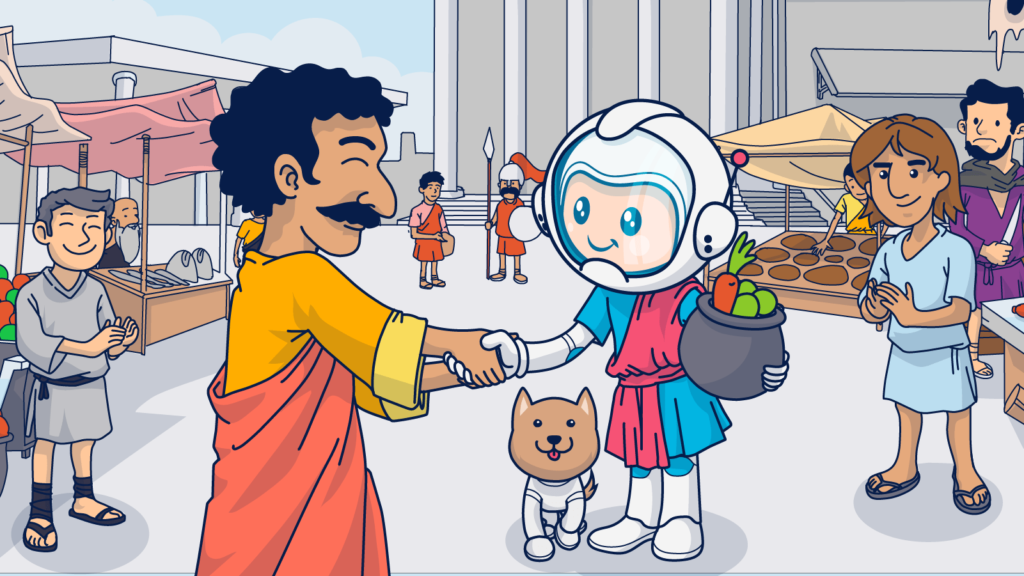
How can you move your subscribers from attention to action in the inbox? Take a few lessons from Greek and Roman scholars and philosophers.
Modern methods of persuasion have their roots in the concepts developed by the Greek philosopher Aristotle and studied by the Romans: Ethos, pathos, and logos.
- Ethos–which means “character” in Greek– is the strategy of using your authority and credibility to convince someone.
- When you make an emotional appeal, you’re using pathos. In Greek, the term means “suffering” and “experience,” and it is the root of the word “empathy.”
- Fact-driven strategies that appeal to reason are descendants of logos. Logos was the word for “word” in Greek. However, its meaning is more complex and akin to our modern-day term, “logic.”
Roman scholars and politicians studied these methods, then added their own unique styles. They recognized that humans are most driven to action by emotion, so they trained to speak with eloquence, passion, and clarity.
Now, here’s how to use persuasive strategies (both old and new) to write inbox copy that captures your subscribers’ attention and compels them to act:
- Highlight your value proposition. Don’t be shy! Tell your subscribers what they’ll get if they open your email.
- Offer a timely solution to a problem. Did your subscribers wait until the last minute to shop? Or maybe they need information to help them solve an operational issue. Tell them how you can help.

In the examples above the subject lines entice subscribers with promises that they can “satisfy compliance needs in spite of limited resources,” or “close the skills gap that holds back” their digital supply chain.
- Use a teaser line to spark curiosity. Reveal just a part of the story, so your subscribers have to open your email to learn more.

“No way, Norway,” is the subject line for this Morning Brew newsletter. What does it mean? The recipient will have to open to find out.
- Use humor or clever plays on words to entertain and entice subscribers. Lighten up your subscribers’ dreary inboxes with a witty quip or pun, some wordplay, or an engaging literary device such as alliteration or repetition.
Here’s how several brands that made their way into my inbox use their language skills to brighten the mood.

Uncommon Goods went with repetition and alliteration with a few emojis for good measure in its inbox copy offering “special gifts handpicked for special people,” and “conveniently collected.” Another alliteration fan, Ann Taylor’s subject line announces “Fall’s perfect pairings.”
The Team at Mouth says, “Meet your maker!” in a subject line that tells the story behind some of the brand’s suppliers. Chubbies introduces a new line of pants with the subject line, “Velour” Not just for VIP Ropes.”
- Ask a question. Questions trigger an instinctive desire to respond. Use a question in your subject line to make your subscribers think–about your brand.

“Ready to make a statement this year?” The Paper Store asks in its subject line.
- Put your CTA in your subject line. “Shop Now,” “Register Today,” “Share your thoughts.” Say what you want right from the start.
- Make an announcement. Be bold. Use your subject line to announce an upcoming event or introduce a product release like Cadillac has done in the emails below.

Cadillac announces its new EVO with “just the beginning” subject line copy and invites subscribers to “get ready” in the above email examples.
- Ask a favor. People enjoy being “owed one,” and being asked for your input is flattering. Engage your subscribers by asking for their help.
- State your offer. If your email includes a great deal, don’t keep it a secret. Have an action- or time-limited incentive, state the specific savings they can realize, or offer a freebie.
- Present social proof or reference an expert. Referencing other consumers or an authority figure can give your subject line an edge over the competition.
This inbox copy from Thrive Causemetics’ uses customer ratings (plus a discount) to support its campaign with, “Thrive Causmetics’ Top Rated – Plus, get 10% off!”

Well+Good references their editors’ expertise to win the click, “The Sephora products our editors use to the last drop.”

- Make your subscribers worry (a little). Exclusivity, scarcity, and fear of missing out (FOMO) are powerful psychological triggers. Use a light touch to elicit these negative feelings in your subject line and offer to help make them go away.
Tinuiti tells me there’s still hope for Q4 in this email subject line and preview copy that says, “Your brand’s design could end up hurting your Q4 sales. Stand out with a data-driven creative strategy this holiday season.”

- Project some positive vibes in your subscribers’ inboxes. You don’t have to go negative to move your subscribers to action. Make them feel good and feel like opening your email with positive psychological triggers.
Develop subject lines that build a sense of belonging and community, appeal to your subscribers’ dreams and aspirations, appeal to their vanity, or show them your appreciation to put them in a clicking kind of mood.
Check the feel-good inbox openers below for inspiration.
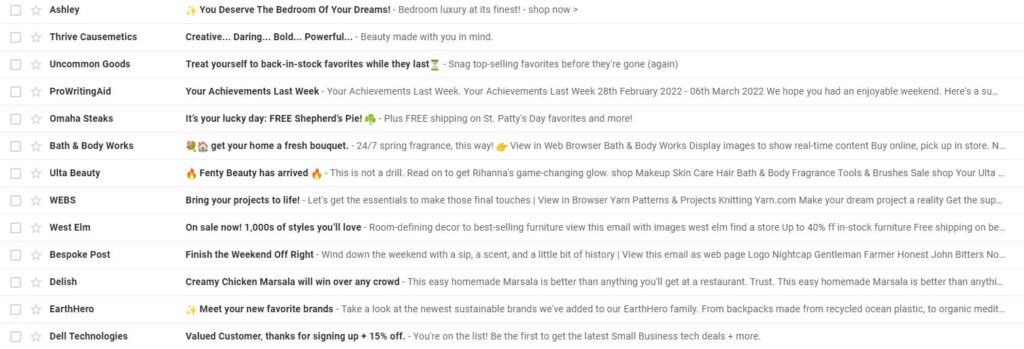
Phrases from this peppy set include:
Valued customer, thanks for signing up…
✨Meet your new favorite brands
Creamy chicken marsala will win over any crowd
Finish the weekend off right
On sale now! 1,000s of styles you’ll love
Bring your projects to life!
🔥Fenty Beauty has arrived 🔥- This is not a drill.
💐🏠Get your home a fresh bouquet.
It’s your lucky day: FREE shepherd’s pie!🍀
Your achievements last week
Treat yourself to back-in-stock favorites while they last ⏳
Creative… Daring… Bold… Powerful…
✨You deserve the bedroom of your dreams!
- Stack your strategies. While you can’t fit every subject line strategy into a single inbox entry, you can manage to craft some awesome mashups.
Use a statistic in a “did you know?” question. Offer problem-solving advice from an expert. Give your subscribers an extra discount as a thank you for their support. You get the idea, and I’m sure you’ll come up with plenty more. Use your performance data to help you develop your winning strategies.
Discover more persuasive devices and copywriting advice in our detailed guide to copywriting for email. Then visit our Valentine’s Day and Mother’s Day email marketing guides to discover holiday-themed subject line suggestions that will win your subscribers attention.
Drive conversions with data-driven email subject lines
So many strategies, so little time. How do you know which subject lines your subscribers will find interesting and engaging? Keep the data coming.
Leverage accurate, up-to-date information to create legendary email campaigns that are as unique as your brand. Commit to a data-driven continuous improvement process and make data collection and evaluation the capstone of your email marketing program from start to finish.
- Look at industry benchmarks and your previous performance to start and strategize new campaigns.
- Use A/B testing to assess new ideas and hypotheses and reevaluate past practices.
- Measure and track the results of each of your campaigns.
- Save and share your data with your team so they can continue to innovate.
Studies conducted by other email marketers or industry thought leaders could provide you with an excellent starting point. But no one can tell you more about how your audience responds to your subject lines than your testing process.
Check this article we wrote about A/B Testing. You’ll find everything you need to design and execute split tests to gain valuable intelligence about your subscribers and the subject lines that work for them.
You can use Ongage’s snapshot and custom reports to keep an eye on changes in your subscribers’ preferences and behaviors with ongoing monitoring of your email campaign performances.
Summing it up: 22 best practices for subject lines that will lead your email campaigns to victory
Getting subscribers to visit your website or take the next best action on their path to purchase through email marketing can’t happen if they don’t read your message. Ensure the success of your email campaigns by following these best practices to create subject lines subscribers can’t miss.
- Choose an inbox copy and style that expresses your brand’s personality.
- Use your subject line and preview copy to kickoff subscribers’ journey toward your conversion action.
- Keep your subject line’s tone of voice topic appropriate.
- Coordinate drip sequence subject lines to tell a continuing story.
- Tailor your content for your audience (or audience segment).
- Use a familiar From name.
- Add a BIMI logo for extra visual impact and credibility.
- Designate your preview text and use this inbox element to complement your subject line.
- Experiment with different characters, fonts, symbols and emojis to see what works with your audience.
- Don’t go overboard with emojis or excess punctuation.
- Use trending phrases–as long as you’re sure you know what they mean.
- Pay attention to character limits and display widths.
- Put your most important content at the front of your subject line.
- Check your inbox display on mobile.
- Personalize your subject lines–and not just with your subscribers name.
- Be authentic and transparent. Don’t use deceptive copy to earn opens.
- Avoid using words or symbols that appear spammy.
- Don’t resend messages using the same subject lines.
- Double-check your email subject lines before you hit send.
- Add details to your subject lines for better engagement.
- Use copywriting techniques such as urgency or curiosity in your subject line and preview text.
Experiment, test, track and reiterate to continually improve your subject lines.
Until we meet again, remember, pauca sed bona! (Quality over quantity).



